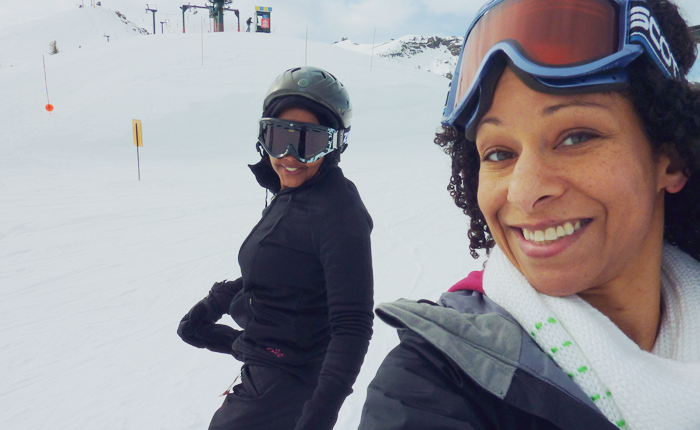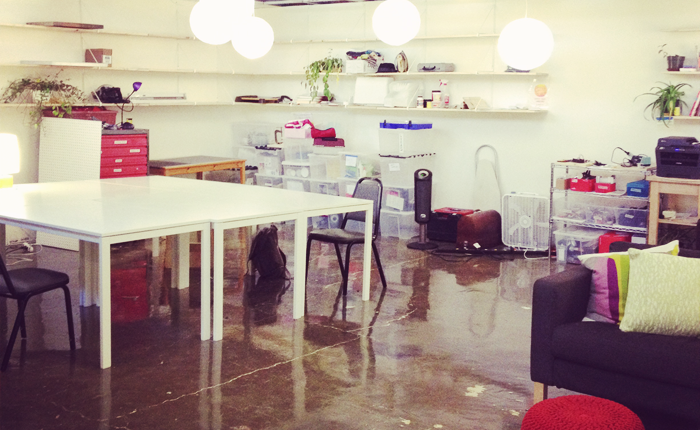Google Glass: Flipping the Script on Small Talk
How introverts can enjoy being social with technology. (Hint: It doesn’t involve looking down at your phone)
Small talk is uncomfortable for a lot people. It’s especially painful if you’re an introvert. Understanding social cues may be easy for some, but for myself and many others working in tech, it’s a code we struggle to decrypt. When you walk into a room of people, two things come to mind: Who do I talk to and what do we talk about? Sure, you can throw back a drink or two – but often you’re the only one who finds yourself more interesting in that condition. The connection between an outgoing personality and success, although not proven, is a generally accepted correlation which can cause more pressure for those who lack the gift of gab.
Glass as a Conversation Starter
From left to right in the photo, the four of us are wearing Glass: myself, Roger, Trinh and Yosun. This photo is from CES this January in Las Vegas. We all know each other from various tech events. We experienced the exponential power of glass as a social lubricant multiplied by 4.
These days when we feel nervous, uncomfortable or bored, we often whip out our smartphones, checking our inboxes and completely checking out from the people around us. In a social situation, this sends the signal: “I don’t want to talk”. In terms of body language, it’s like your arms crossed over your chest.
This is where Google Glass can be a lifesaver. Rather than figuring out who to approach, people actually come up to you. They find the gadget sitting on your face so compelling, they drop social pretenses and approach. Since Glass allows you to keep looking up, people can see you and you can see them. Astonishing! Your body language reads that you’re open and available to talk vs your head ducked down on a smartphone. I’ve seen this phenomena in action and had it happen to me. All of a sudden you have a topic, questions to answer and your experience to share.
This is my tweet from last year that got me selected for the Google Glass Explorer program. As a life-long introvert, an INTJ to be specific, I’ve always preferred to spend time alone but have learned how to authentically enjoy spending time with others, especially at large conferences.
“#ifihadglass I would show introverts how to create authentic connections in real life like I’ve learned to do” source
When I talk with people about Glass, topics include:
- Technical aspects of Glass covering hardware and software functionality
- Giving a hands-on demo how Glass works
- Showing off Glass apps
- Discussing the potential of Glass in various industries
- Brainstorming potential API inputs for apps
- Considering the availability of Glass to the public and the cost
- Debating Google Glass privacy concerns
- Learning about the Glass marketplace (and conversing about lack of an open one for developers!)
I don’t wear Glass on the street often. I didn’t Glass at DEFCON. I wear Glass at conferences and events that are focused on tech. I’ve worn Glass volunteering with students learning to code, as a way to expand their horizons for what is possible in tech and of course give them the chance to try out Glass.
Here’s a photo of girls, nine to eleven years old who are a part of the University of San Francisco summer computer science program. They visited Mozilla to learn how to build mobile apps, and I volunteered to talk in the morning with them about opportunities in tech. In the afternoon, we helped them build their own apps. During lunch they all wanted to try on my Glass so they lined up and I spent time showing each one of them how to take a photo or video with Glass. Some of their expressions were priceless once they got the hang of Glass!
USF Mozilla Girls Google Glass Demo
Now, the thought of handing over something valued at $1,500 to a total stranger is something that may turn some people’s stomachs. I’m proud to share that over 100 people have tried on my Glass and not one has damaged them. I call this “stranger trust”. It’s the same when you ask a total stranger at a coffee shop to watch your laptop while you use the bathroom.
It’s not just Google Glass that can help you have new interactions
I remember hearing about a guy who would show up at events in Silicon Valley with a huge WWE-like wrestling belt slung over his shoulder. Just like Glass, people would notice it, ask to try it on and ask questions about it. Think of anything that makes you stand out: a hairstyle, a tattoo, heckstickers on your laptop are a good conversation starter.
When I would be walking my dog Bluey, the same sort of response would happen. I was surprised at how many different types of people would approach.
I used to hate small talk.
Microsoft Build Conference Party 2012 – Redmond, WA
When I moved to San Francisco, it felt like I had a new start. I looked around and it seemed EVERYONE was working in tech. I had been going to user groups and conferences in Minneapolis since 2003, plus I’d been a member of Meetup.com since 2006 but had found these events full of people like myself. The Bay Area felt different. Friendly and outgoing.
This was an opportunity to reshape my experience.
When faced with a crowded room of people, I started to look for things I had in common, like growing up in the Midwest, snowboarding and my love of bacon. Sometimes it was as simple as finding someone who looked like me although finding another Black, Jewish woman was a tall order in any industry.
This photo is a great example. In it Anisha and I are snowboarding at Tahoe. I met Anisha through Yelp. I was new to the Bay Area in 2010 and wanted to go snowboarding. While reviewing ski resorts I saw Anisha’s avatar and reached out. We talked and agreed to meetup for a day in Tahoe and had a fantastic time! We’re still friends to this day.
Anisha and Adria snowboarding at Tahoe
Sometimes it would be something the person was wearing, like a cool shirt design, and I would walk over to talk to them about it. I made sure I wore cool shirts too, giving other people a chance to approach me. I would strike up a conversation about the event: Had they been before? What was their favorite part? I found over time that being a good listener was an easy way to network.
The Buddy System is also very effective; I would often go to events with someone else and we would circulate together and separately. I found it was easier to introduce my friend and highlight their professional accomplishments then my own so this turned out to be a great way to be social without feeling in the spotlight. We would compare notes at the end of the night about who we met. Another strategy I used was going to events with extroverts; outgoing people who just love to tell stories, be the center of attention and love an audience. This allowed me to be part of things with less pressure.
I came to understand that many people in tech felt the same awkwardness I did when it came to being social. That made it even easier to approach knowing they probably didn’t know how say hello either. I feel now I’m an ambivert, a mix of introvertism and extrovertism, enjoying my personal time but looking forward to connecting in social situations with others.
So, how do you encourage authentic, in-person connections with other people?
Think of what you can do to spark a conversation next time you’re in a crowd. Small talk is an essential part of human interaction, allowing us to quickly connect on shared interests and diffuse that uncomfortable feeling. If things go well, we can delve into deeper conversations that we care about. As with many things, awareness is the first step to change.
You must step out of your comfort zone in order to grow and become a better version of yourself.








